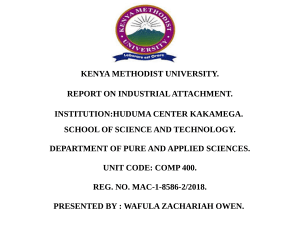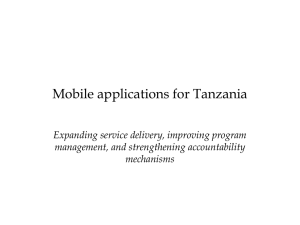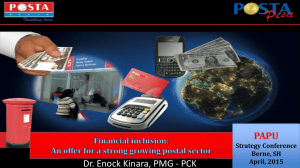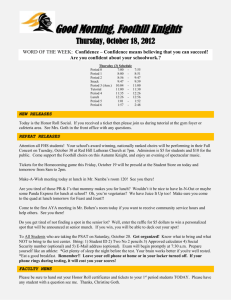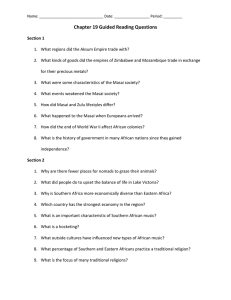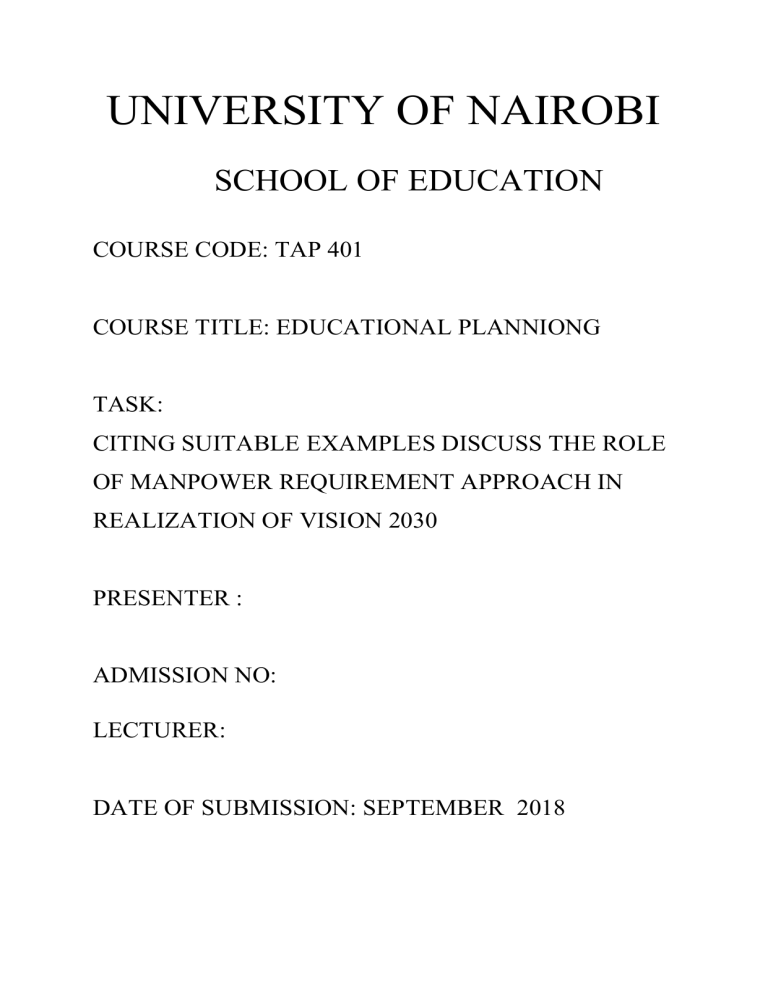
UNIVERSITY OF NAIROBI SCHOOL OF EDUCATION COURSE CODE: TAP 401 COURSE TITLE: EDUCATIONAL PLANNIONG TASK: CITING SUITABLE EXAMPLES DISCUSS THE ROLE OF MANPOWER REQUIREMENT APPROACH IN REALIZATION OF VISION 2030 PRESENTER : ADMISSION NO: LECTURER: DATE OF SUBMISSION: SEPTEMBER 2018 TABLE OF CONTENTS BASED ON A TOPIC OF YOUR CHOICE WRITE AN ESSAY (EXPOSITORY, CAUSE EFFECT ARGUMENTATIVE) ABSTRACT Huduma Namba initiative is anchored on Executive Order No.1of 2018 and Sec.9A of the Registration of Persons Act, 2018. The programme is envisioned to develop a National Integrated Biometric Population Database of information on persons’ Identify for all Kenya Citizens and Foreign Nationals residing in Kenya. The system is also aimed at assigning a Unique Personal Identification Number that will be critical in enhancing government planning and efficient service delivery. Huduma Namba is a useful tool for the government to use in national planning, social services, project resource allocation, and even project infrastructure. It is conducted by the National Integrated Identity Management system (NIIMS) and involves collecting biometric data after which the systems generates a unique number (Huduma Namba). No other document gives the government the ability to serve its people that way. Once done, the Huduma Namba will be the only identification document you will need. Without it, it will be difficult to access any government services that require documentation, just as you cannot do so without a national ID card. INTRODUCTION In order to ensure smooth registration process,one is required required to have the following documents:a) Mandatory Documents: –i. A valid Kenya passport or a Kenya National Identity Card (ID) for persons aged eighteen (18) years and above. ii. A Certificate of birth for persons below 18 years.b) Other documents that you may require during the registration include: i. Driving Licence ii. National Hospital Insurance Fund (NHIF) Cardiii. National Social Security Fund (NSSF) Cardiiii. Kenya Revenue Authority PIN and any other relevant documents. The Registration officer will need to capture your biometrics and photo image of your documents. Children Below the Age of 6 Years will not be required to provide biometrics. The biometrics and document capture cannot be executed unless the applicant has completed the online application form. A new website for the process was launched to enable Kenyans to download the registration form so that they fill at convenience and take to the registration centers.The registration is for Kenyans aged six and above. In this regard younger children will be captured on the system under the parents or guardians ‘profile’. The mandatory documents required to register for a Kenyan citizen above 18 years of age is an original national ID card and those below 18 years an original birth certificate.Foreign residents are required to bring their passports or alien cards. All these documents are recorded in different databases so Huduma Namba consolidates the information to arrive at the ‘single source of truth’ regarding a Kenyan. There is no new data the government is looking for nor is DNA needed. Those who may not have these documents should present themselves to the NIIMS registration officers for further guidance.Other information required, where applicable, includes:Place of birth,Disability registration number,National Hospital Insurance Fund (NHIF) number,National Social Security Number (NSSF),Passport number and expiry date,Birth Certificate Entry number,Driver’s license number,Kenya Revenue Authority (KRA) Personal Identification Number (PIN),Marital status and spouse name and ID/Passport number,Parent or Guardian name and ID/Passport number,Permanent and Current address, Contact details, National Education Management Information System (NEMIS) number. The first stage of registration involves filling a form (hard copy) containing your photos, biometrics, and biodata. After that, this data will be moved to the registration kit that helps in storing all the captured information locally. The third stage involves uploading the information to the server before it is entered in the Huduma Namba Server. Finally, your Unique Personal Identity (UPI) will be generated. There is no online registration, and you will need to present yourself physically by the 18th of May 2019. The entire process was initially scheduled to take 30 days, but it was further extended to 45 days. Registration for Huduma Namba (Number) is currently not done online because you are required to present yourself physically. For those within the country during the registration period, they can present themselves to any registration center between 7 am and 5 pm every day of the week. Registration will take place in every sub-location in the country under the supervision of the Assistant Chief. It will involve both fixed and mobile registration points. For information on the exact location in your sub-location where registration is taking place, please check with the nearest Assistant Chief. Citizens outside of the country can submit their information on the Huduma Namba portal but will be advised in due course on how their fingerprints and photos will be captured. The law of the Republic recognizes the number and process of registration. Relevant laws have already been enacted; therefore, no litigation can deter the rollout. The Registration of Persons Act was amended and endorsed in the national assembly to comprise data capture and digital biometric. Also, the Huduma Namba Bill has already been tabled in parliament to offer provisions for the protection of information as well as include consent to capture the information. PROCESS Step 1: You will fill in a hard copy that contains your bio data, biometrics. The registration officer will also need to take a photo of you, take fingerprints and ask you to sign or use your thumbprint in order to finish the registration process. Step 2: This information is transferred to a registration kit that stores captured data locally Step 3: At the end of the day, the information is uploaded to the server Step 4: The data is then the fed to the Huduma Namba Server and UPI is generated. Note: The Huduma Namba will not be issued during the mass registration exercise as there are several steps before it is issued. After successful verification of the data then a Huduma Namba will be issued. However all those registered will receive an acknowledgment slip to signify that their data has been captured. After the registration, the gadgets will be left with the chiefs to continue updating the digital register with information such as births, deaths, marriages, and any other updates. What happens when a person's registration details change? (Marital status, employment status, current physical address education details, etc) When a persons’ registration details change, they should contact the mandated agency who will update their details. For example, if a child attains the age of 18 years they should contact the National Registration Bureau (NRB). Also, should a person die, their next of kin should contact the Civil Registration Service (CRS). The operationalization of the Huduma Namba will lead to harmonization of this in due course. What are the benefits of registering for Huduma Namba? The Huduma Namba will make the lives of Kenyans easy. Once data is captured digitally, you will never again have to queue to submit new data unless you choose to. In the same way that your driver’s license or national ID have the original photo taken as a teenager, so too shall the Huduma Namba. Single identification numbers have been used in the West to help governments plan; disburse benefits such as welfare, healthcare, housing, and agriculture.The government hopes Huduma Namba will play a similar role in channeling resources to the elderly, school children, the disabled, members of the proposed housing fund, small and medium enterprises and farmers. It also hopes the number would aid in combating fraud. It could also help check the unwanted entry into the country by foreigners in the wake of terrorist threats and attacks. The development of the NIIMS system has taken into account international best practice and global standards in the collection, transmission, and storage of all collected data. The data will only accessible by authorized officers and government agencies for official use only. Laws have been put in place to ensure no litigation hinders the rollout of this programme. The Registration of Persons Act was amended in the National Assembly to include digital biometric and data capture. A standalone Huduma Namba Bill is currently in Parliament and it includes permission to capture data as well as makes provisions for the protection of that information. Kenyans are guaranteed protection to any personal information submitted on the portal. According to the ruling by the three High Court judges, it is in public interest that such systems that collect your personal information never infringe on any of your rights. Moreover, other sections of the process were scrapped off such as the collection of GPS information and DNA samples. CONCLUSION Huduma Namba is a free service by the government of Kenya handled by the National Integrated Identity Management Systems (NIIMS). The directive by President Uhuru Kenyatta is aimed at ensuring all Kenyans are digitally registered and issued with a government Huduma identification number. It has been subject to debate with citizens from different parts of the country giving different views on the same. The registration is currently taking place countrywide, and Kenyans from all corners of the country are encouraged to participate. However, it is an entirely voluntary affair, and you will not be forced by anyone to surrender your information or documents without your consent. This is according to a court ruling that allowed the process to go on but on several conditions. Still, the emphasis has been put on Kenyan citizens by naturalization, birth, or naturalization to register. REFERENCES Friedrich, G.W. (1991). Essentials of speech communication. In Morreale S., Janusik, L., Randall, M., & Vogl, M. (Eds.), Communication Programs: Rationale and Review Kit. (1997). Annandale, VA: Speech Communication Association, p. 125 Applegate, J. & Morreale, S. (May, 2001). Creating engaged disciplines. In Hendley, V. (Ed.) AAHE Bulletin, 53 (9). Washington, DC: American Association for Higher Education. l https://diaspora.hudumanamba.go.ke www.standardmedia.co.ke www.google.com/huduma namba -kwnya
